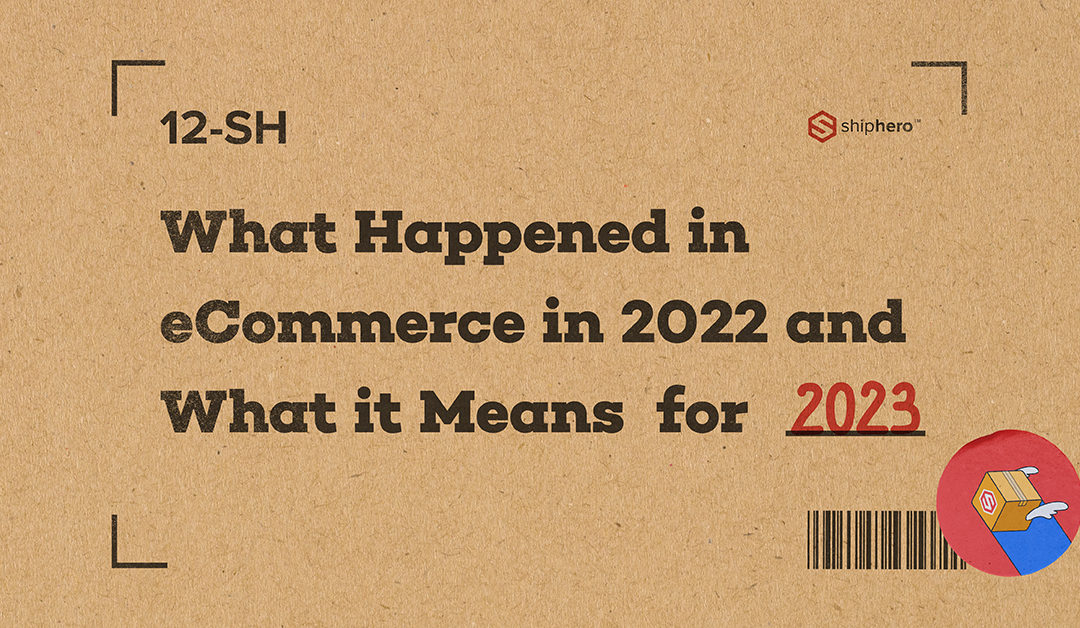
Dec 16, 2022 | Blog, Fulfillment, Warehouse Management Software
It’s hard to believe that we’re already at the end of 2022, but as we all know, time flies! The eCommerce landscape of 2022 has been a wild ride, from fulfillment technology advancements to mobile commerce innovations and seamless omnichannel experiences. As 2023 rolls around, all these developments mean one thing: Companies need to stay on their toes and continue adapting their eCommerce strategy to the latest advancements to stay ahead of their competitors in the highly competitive eCommerce space. A lot has happened, so let’s look back at some of the biggest eCommerce developments in 2022 and see what they mean for 2023.
Mobile Shopping’s Rise to Power
eCommerce has come a long way since its inception, and the rise of mobile shopping is a testament to this. Mobile commerce volume is expected to hit $620.97 billion by 2024. This means nearly half (42.9%) of all eCommerce purchases will be made via a mobile device. eCommerce companies should fine-tune their strategies to cater to the increasingly mobile-savvy consumer.
More and more shoppers are investigating products on their phones before deciding which to buy. Plus, with handier features and conveniences, they can enjoy the ultimate comfort while browsing and making purchases at their fingertips! The rise of mobile shopping gives eCommerce businesses more opportunities than ever to increase customer engagement and drive up profits.
Omnichannel Selling
eCommerce is a rapidly growing juggernaut of a marketplace, and one of the biggest trends to keep an eye on is omnichannel selling. Technically speaking, this strategy allows you to reach customers in as many channels as you can think up – from in-store purchases and eCommerce sites to social media platforms, email campaigns, and beyond! But what does it mean for businesses? Well, for starters, it means that staying ahead of eCommerce trends has never been more important!
A successful omnichannel approach can bring numerous advantages; shoppers are no longer held to traditional hours or wait times when trying to reach an employee. Thanks to an eCommerce store that operates 24/7 and ways to reach customer support, even after business hours have ended. Additionally, with strong SEO practices and clever content marketing at play behind the scenes, customers find their way through different touchpoints right into your eCommerce store. All these advantages add up.
eCommerce Goes Social
In the modern eCommerce landscape, it’s become increasingly important for businesses to cultivate a presence on social media. With more people flocking to platforms like Facebook and Instagram, eCommerce companies are turning to social commerce models as an easy way to engage potential shoppers and increase brand exposure.
This trend has only been further augmented by clever influencer campaigns and sponsored content that drives measurable results. Ultimately, leveraging eCommerce trends and social media allows businesses to acquire and convert more customers quickly. It’s no surprise that companies are increasingly looking at social media as a viable eCommerce channel – once again proving how impactful this powerful medium can be!
Immersive Experiences with AI and AR
eCommerce trends are ever-evolving and staying on the cutting edge can be challenging. One of the most prominent eCommerce trends is using AI, automation, and Augmented Reality (AR) to improve customer service and experience. Although AI applications have been around for a while, only recently have eCommerce organizations taken full advantage of their potential in their technology stack.
With AI and AR capabilities, eCommerce companies can go beyond mere personalization to create immersive shopping experiences with product recommendations tailored to an individual’s needs, virtual or augmented store environments that shoppers can explore without leaving home, and even eCommerce versions of the metaverse complete with avatars navigating life-like simulated stores. Together these tools represent just some of the ways AI has enabled eCommerce companies to enhance their customers’ experiences while streamlining their operations simultaneously – something they’ll no doubt be capitalizing on more and more in the coming years!
Using Technology to Optimize Labor
eCommerce trends continue to accelerate, and with peak seasons arriving earlier each year, warehouses are under immense pressure to find ways to optimize labor for order fulfillment. In the past, the answer was to hire more workers – throw bodies at the problem, as it were. But in today’s tight labor market, such a strategy isn’t feasible.
Thankfully, engineers and technologists have developed solutions to keep eCommerce operations running smoothly while requiring fewer employees on the warehouse floor. The development of robust eCommerce technologies like advanced warehouse management means warehouses can maintain high throughput rates with fewer people. However, warehouse managers know there’s still no better way to fulfill orders than by leveraging extra manpower during peak season – even if only for a few weeks each year. With dedicated teams using the most up-to-date eCommerce tools combined with clever coordination of optimal resources, there’s no eCommerce challenge too complex for any warehouse.
What Does This Mean for 2023?
As we enter 2023, it feels like eCommerce is on a rollercoaster. Technological innovations and consumer expectations have changed almost constantly, and retailers must reimagine themselves to stay in business. But amidst all the chaos, there are two reliable retail trends that every business can count on: change and innovation.
Retailers need to adapt faster and move with agility regarding eCommerce trends like fulfillment, mobile commerce, omnichannel experiences, social media presence, and the use of AI. It’s about more than just “keeping up.” Businesses must lead the way to stay ahead of their competitors. They need to be smart about recognizing eCommerce trends as they emerge and being prepared for customers’ needs today so that they’re ready for whatever tomorrow might bring. With the right strategies in place and a willingness to innovate swiftly, companies will be well-positioned for success come 2023.
eCommerce Continues to Evolve
eCommerce trends in the eCommerce space are nothing short of amazing. eCommerce brings many fulfillment options for sellers, from same-day deliveries to improved returns processes, giving consumers more power than ever. eCommerce lets businesses enter the domain of mobile commerce, where they can quickly reach their target audience and foster more relationships. As eCommerce continues to evolve, we can expect greater convenience for shoppers and improved management capabilities for sellers to meet their customer’s needs and desires in real-time. The eCommerce landscape is exciting and rapidly changing – one thing is clear – the future promises immense opportunities for online business owners!
If you’re looking for a software and fulfillment solution that can scale your business, ShipHero has you covered. We offer direct integrations with various popular eCommerce platforms and marketplaces, making it easy to get started. Plus, we constantly work on adding new features and integrations so that you can keep up with the latest eCommerce trends. Ready to start shipping like a pro?

Maggie M. Barnett, Esq. COO of ShipHero
ShipHero
About the author: Maggie M. Barnett, Esq., is the COO of ShipHero. She is responsible for planning and executing the overall operational, legal, managerial and administrative procedures, reporting structures and operational controls of the organization. Barnett’s greatest strengths are leadership, risk mitigation, change management and a passion for business transformation. She is known for her expertise in delivering operational excellence and an ability to provide guidance and mitigating risk. Her leadership of ShipHero is grounded in a servant mentality, always doing the right thing for our stakeholders. Her passion for ShipHero comes from the ability to drive operational excellence throughout the organization impacting the lives of our employees, customers, and partners.
Follow Maggie on Twitter & LinkedIn.

Dec 22, 2022 | Blog, Podcast, Warehouse Management Software
How to Cut Shipping Costs without sacrificing Customer Satisfaction
In this PalletSide Chat podcast episode, we’re sharing a panel, hosted by our own COO Maggie Barnett for FounderMade East. Speaking with Brett Tepper from ModKat and Rich Brewer from Boutique Brands, they discuss practical solutions for keeping shipping costs low and customers happy. They cover everything from optimizing fulfillment processes to utilizing technology effectively.
Most business owners know that reducing shipping costs is a major priority, but it can be tricky to do so without alienating customers. It can be daunting, but with the right advice, it can be done without sacrificing customer satisfaction. This expert panel will teach you how to keep your customers happy while shaving dollars off your shipping bill. Tune in for the tips and tricks these experts have gleaned from their own experiences running successful eCommerce businesses in an ever-changing landscape. Shipping rates may be skyrocketing, but that doesn’t mean your eCommerce business has to suffer!
The Litter Box Business
When it comes to litter boxes, even the most design-savvy among us can be taken by surprise. Just ask Brett Tepper and his business partner, who found themselves unexpectedly in charge of cat box duty. What they discovered was a litter box that was, in their words, “not happening.” The following day, Tepper’s business partner came in with an idea for a better design.
Thus began a journey that would take them from Walmart to Taiwan and eventually result in a successful product. Today, Tepper and his partner continue to work with the same manufacturer, and their litter box remains one of the most popular on the market. They are considered “OGs” of the Shopify world, as they were one of the first 300 people to use the platform. Who would have thought such a simple, but smelly, idea could lead to success?
“So I had a few developers lined up, and then one of the developers said, ‘Have you heard of Shopify?’ So I started looking into it, and I was like, ‘This is it.’ Yeah, they have been with it since.” -Brett Tepper.
How ModKat Handles Exploding Freight Costs
ModKat prides itself on being able to adapt to change. So when the pandemic hit and their sales exploded, it was a happy challenge. However, soon they found themselves facing a different problem: exploding freight costs. Freight bills soared from $6,000 per container to $12,000, then $18,000, eventually topped at an astonishing $32,000. They knew they had to make tough choices to keep their business afloat. They started by eliminating free shipping, then slowly escalated prices.
With four primary sets of SKUs, ModKat has increased pricing on their higher-end litter boxes. The downside to shipping litter boxes is that they are big, so they all hit dim weight and can only fit a few per container. With a 40-ft HQ container, they can only fit about 550 of their largest litter boxes. This directly affects the pricing scale, so that’s where most of the cost-cutting has been done. Fortunately, they have enough margin on the refills to keep them at the same price. The other great thing about the litter box liners is that they fold flat and ship small, so freight doesn’t affect them as much.
How ShipHero Has Helped
If you’ve ever worked in eCommerce, you know a lot goes into fulfilling orders. And if you are doing it yourself, a whole other stress level comes with it. That’s why ModKat outsourced fulfillment to a 3PL when Tepper started his business. But then, around 2012, he got a 5,000-square-foot space and started prepping orders himself. Tepper mentions that it was great and awful at the same time. He learned a ton about how fulfillment works and why 3PLs work a certain way. But after a year, he realized it wasn’t a tenable situation and returned to using a 3PL. He’d been with the same one for seven years but recently switched to ShipHero. If you’ve thought about fulfilling orders yourself, Tepper says go for it – but be prepared for many long nights (and early mornings).
ModKat went back to dim weight and because of that, they had four warehouses with their old 3PL, and keeping inventory in all four warehouses was difficult. That was taking up a ton of their time, just ordering correctly for all warehouses. So, knowing that ShipHero did load balancing was a massive thing for ModKat. Then on top of that, ShipHero also consolidates shipments. Which saved them a ton of money on shipping costs. So all of those things allowed ModKat to focus on other parts of their business rather than just managing logistics all the time.
Boutique Brands
In the world of fast fashion, speed is everything. That’s why Rich Brewer of Boutique Brands has made it his mission to streamline the fashion ecosystem and help his employees move more quickly. By streamlining the process from manufacturing to reselling, Brewer and his team can turn inventory faster and keep up with the latest trends. And they’re not stopping there. They’re also constantly reviewing their website and ensuring they appeal to customers. It’s all about staying ahead of the competition and keeping costs down.
Automation, Automation, Automation
As an eCommerce business knows, shipping costs can eat into profits quickly. But what happens when a company returns to charging for shipping? It’s not easy to tell customers that they now have to pay after getting used to free shipping. And it’s even harder to do it in a way that doesn’t damage the customer relationship. That’s why it’s important to have systems that allow you to rate shop among carriers and find the most cost-effective option for each shipment. By automating the process as much as possible, you can minimize the impact on your bottom line and keep your customers happy.
The Return Process
Returns are allowed at Boutique Brands. There are, however, some brands that charge shipping to and from their stores. Occasionally, customers have to print a label and pay for it, but Brewer is working to simplify the process. They have yet to do exchanges, which Brewer wants to implement because that will cut down on the total loss of revenue from returns if they can use a system like Happy Returns. It automatically creates a product on Shopify. Customer service teams can then click a button and be done. Brewer is currently engaged in analyzing what’s working, what’s not, and who has the best return on investment for returns.
“We are more or less just maximizing every automation we can maximize.” -Rich Brewer.
Provider transparency
Provider transparency is something that has become increasingly important in recent years. Consumers want to know where their products come from and how they are made. They also want to be able to track their orders and see precisely where they are at all times. This level of transparency can be challenging to achieve, but it is something Flexport is working hard to provide. While the data isn’t always up to date, ModKat appreciates the insight Flexport (a freight-forwarder) gives them into the supply chain process.
Recently, ModKat has been dealing with some supply chain issues beyond its control. They have had to ration inventory and cancel orders, and their customers have understandably been frustrated. In response, they created a feature on their website where people can sign up to be notified when an item comes back in stock. They thought this would help alleviate some of the frustration, but it turns out that people get even more frustrated when they get 100 notifications that an item is back in stock, only to find that it’s already sold out again. Despite the challenges, Tepper is grateful for his loyal customers and will continue to do everything he can to keep them happy.
Preparing for the Next 12 Months
Over the last three years, the world has been turned upside down. We have seen economic turmoil, political upheaval, and a global pandemic. So what are ModKat and Boutique Brands doing to prepare for the next 12 months? For starters, they’re stocking up on essentials. ModKat is ordering like crazy, trying to get as much inventory as possible. They’re also trying to figure out ways to pep up their customers. At some point, they plan to reintroduce free shipping or offer discounts. But the most important thing is that they’re getting back on their feet. The sales are picking up, and they see more customers every day. ModKat is excited about the future and ready to take on whatever comes its way.
For Boutique Brands, maximizing automation is their key to success. By using data to select styles that are in demand, and cost-effective carriers, brands can reduce costs while still providing the latest trends to customers. Additionally, expanding social media outreach and implementing loyalty programs can help increase brand visibility and customer engagement. By taking advantage of these various marketing and operational strategies, Boutique Brands can stay ahead of the competition and keep their businesses growing.
“We’re actually ramping up our influencer campaigns, our UGC, our loyalty programs. All of this stuff is going into play to basically drive more business to help mitigate the additional costs.” -Rich Brewer.
Turn the Challenges of Today’s Marketplace into Opportunities for Tomorrow’s Success
If there’s one thing that’s certain in eCommerce, it’s that shipping rates are always on the rise. Carriers announce new rate increases yearly that can eat into your profits if you’re not careful. But don’t despair – there are still ways to keep your shipping costs under control, even in the face of rising rates. Optimizing your fulfillment processes and utilizing technology effectively can minimize the impact of rate hikes on your business. By streamlining your operations and using shipping rates as a lever to drive customer loyalty, you can turn the challenges of today’s marketplace into opportunities for tomorrow’s success. So don’t let rising shipping rates get you down – use them to fuel your eCommerce success.
The FounderMade East panel was hosted by ShipHero’s COO, Maggie Barnett, and she was joined by Brett Tepper, the co-founder of ModKat, and Rich Brewer, the product manager at Boutique Brands. This session is packed with great information for anyone in eCommerce, whether you outsource your fulfillment or manage it in-house. So, take a moment and listen to the full panel or watch it on YouTube!
—
About the Panel Host: Maggie M. Barnett, Esq., is the COO of ShipHero. She is responsible for planning and executing the overall operational, legal, managerial, and administrative procedures, reporting structures, and operational controls of the organization. Barnett’s greatest strengths are leadership, risk mitigation, change management, and a passion for business transformation. She is known for her expertise in delivering operational excellence and her ability to provide guidance and mitigate risk. Her leadership of ShipHero is grounded in a servant mentality, always doing the right thing for our stakeholders. Her passion for ShipHero comes from the ability to drive operational excellence throughout the organization impacting the lives of our employees, customers, and partners.
Follow Maggie on Twitter & LinkedIn.
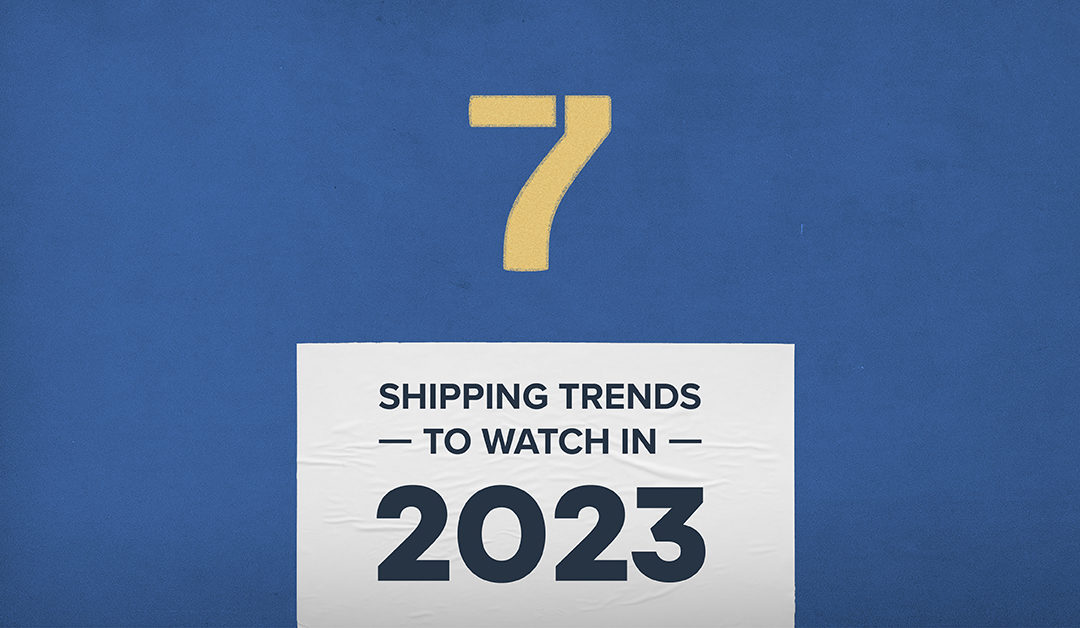
Dec 23, 2022 | Blog, Fulfillment, Warehouse Management Software
It’s no secret that the shipping industry has seen significant changes in the last few years. Retailers have had to adjust their operations due to port delays, labor shortages, and inflation. As we move into 2023, there are several key trends that retailers should be aware of. From load balancing to sustainable packaging and fast order fulfillment, here are seven shipping trends to watch out for in the new year.
1. In 2023, Supply Chain Concerns Will Persist
Anyone who’s tried to order a simple item online lately knows that supply chains are majorly screwy right now. Thanks to a global pandemic, war conflict, and port delays, shipping and manufacturing delays have become the norm rather than the exception.
In February 2022, only about 34% of container vessels arrived at their destination with no delay. And according to our research, 39% of brands say shipping and manufacturing delays and shipping costs will continue to be a top supply-chain-related challenge over the next 12 months.
Fortunately, most retailers acknowledge it will take time to unravel the challenges associated with shipping delays and the supply chain. In the meantime, there are some things consumers can do to ease the burden.
2. More Efficient Shipping with Load Balancing
No retailer wants to be known as a company with terrible shipping. Customers expect efficient shipping; anything less can damage a company’s reputation. Shipping is one of the most significant expenses for a retailer. So, this is where load balancing has come in.
Load balancing is a popular method of reducing shipping and warehouse costs by distributing shipments evenly across multiple carriers. Getting products closer to your customer through distribution centers helps to avoid service disruptions and delays. Studies have shown that load balancing can save up to 25% on shipping costs. In addition, load balancing can reduce your total costs by up to 13%.
While load balancing has many benefits, it is not without its challenges. It takes coordination and a good warehouse management software system to work efficiently. However, the savings are definitely worth the effort. Load balancing has only gained popularity in recent years, but it is expected to grow even more as retailers realize the benefits.
3. Agile Supply Chains
Agile supply chains are designed to be highly flexible and responsive, so businesses can quickly make changes as needed. Shifting from ‘just-in-time’ to a more stable ‘just-in-case’ model allows brands to respond to more supply chain setbacks.
While it may be impossible to insulate one’s company from another global pandemic, operating with more robust inventory levels may help companies to overcome supply chain obstacles and maintain the integrity of fulfillment channels. In other words, the days of “set it and forget it” shipping are long gone.
Businesses need to be prepared for anything and everything, which means having a supply chain that can quickly adapt as needed. Recently, I discussed this same challenge with Shopify and other leaders in fulfillment; you can find the full article here.
4. The Future of eCommerce is Green
As the world becomes more conscious of the need to protect the environment, sustainable packaging is set to become one of the most critical industry trends.
Order fulfillment companies are already beginning to place a greater emphasis on sustainability, with 46% of customers indicating that they are more likely to purchase a product online if they recycle the packaging.
In addition to meeting customer demand, this shift will also help reduce eCommerce emissions, which currently account for six times as much pollution as products purchased in-store.
Placing their sustainable shipping and returns values at the forefront of their offering makes it easier for customers to buy in. Sustainable packaging isn’t just good for the environment – it’s good for business too.
5. Keep Customers Happy with Transparent Shipping
Customers today expect more than just fast delivery times; they also expect accurate delivery times. That’s why delivery time accuracy and transparency are becoming increasingly important for businesses of all sizes.
Customers expect brands to be upfront about delivery times with today’s supply chain disruptions and ever-changing shipping costs. After all, no one likes getting their hopes up for a package that ends up being late.
But it’s not just about meeting delivery expectations—it’s also about setting realistic ones in the first place. Brands that overpromise and underdeliver risk damaging customer relationships beyond repair. Research shows that 32% of customers have abandoned a cart because “the estimated shipping time was too long” and 22% because “there was no guaranteed delivery date.”
Looking ahead to 2023, developing transparency and trust around shipping will be critical to building long-term customer relationships—relationships strong enough to weather any industry challenges that come your way.
6. Shipping Cost Relief is in Sight
We all know how important shipping is to eCommerce. And, after a rocky few years, 2023 is shaping up to be a good year for shipping. Thanks to continued innovation in logistics and transportation, we can expect cheaper shipping costs and less port congestion.
While there may still be some disruptions in the supply chain, retailers are finally starting to feel some relief. According to the Freightos Baltic Index, in Q4, the global average cost of shipping a container is $3,429, compared to a whopping $10,396 in October 2021. Lower container costs and fewer backlogs should help retail brands keep shipping rates lower for consumers. So far, so good!
7. 3PLs: Make eCommerce Shipping Easy
As eCommerce businesses continue to grow and expand, many find they need more help than they can handle. This is where third-party logistics providers (3PLs) come in. 3PLs specialize in managing all aspects of the shipping process for their clients, from warehousing and fulfillment to transportation and tracking. By partnering with a 3PL, you can free up valuable time and resources so that you can focus on what you do best.
With pre-negotiated contracts and a network of fulfillment centers spread across the country and worldwide, a 3PL can offload the time and stress of managing shipping logistics in-house while keeping costs down. As e-commerce continues to grow, we can expect even more innovation from 3PLs as they strive to provide the best possible service to their clients.
Order Fulfillment Solution for the Modern Retailer
If you’re feeling overwhelmed by the logistics of shipping in 2023, never fear! ShipHero is here to help. We’ve outlined the seven most important shipping trends for retailers this year, and we’ll continue to monitor these trends as they evolve.
Plus, ShipHero offers an end-to-end, full-service fulfillment solution that leverages the reach of our seven owned and operated warehouses (strategically placed across the country and Canada). So, if you’re looking for a way to outsource your supply chain and shipping needs, consider partnering with a 3PL like ShipHero. Let us take care of the fulfillment so you can focus on what you do best – selling products!
—

Maggie M. Barnett, Esq. COO of ShipHero
About the author: Maggie M. Barnett, Esq., is the COO of ShipHero. She is responsible for planning and executing the overall operational, legal, managerial, and administrative procedures, reporting structures, and operational controls of the organization. Barnett’s greatest strengths are leadership, risk mitigation, change management, and a passion for business transformation. She is known for her expertise in delivering operational excellence and ability to provide guidance and mitigate risk. Her leadership of ShipHero is grounded in a servant mentality, always doing the right thing for our stakeholders. Her passion for ShipHero comes from the ability to drive operational excellence throughout the organization impacting the lives of our employees, customers, and partners.
Follow Maggie on Twitter & LinkedIn.
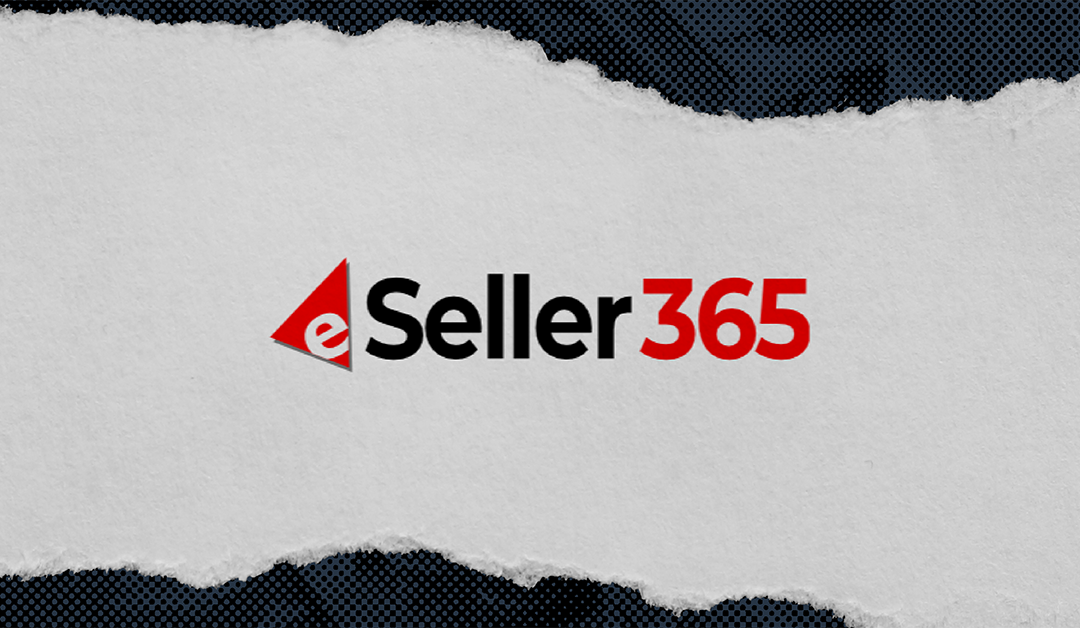
Jan 3, 2023 | newsroom
As 2022 comes to a close, we have once again compiled the largest collection of ecommerce experts and leaders to share their 2023 ecommerce predictions. Whilst it is impossible to truly predict what the next year will have in store, (Nobody saw the Ukraine conflict coming) with this amount of industry expertise we are confident there is something that every ecommerce business can take away and implement in the New Year.
Read more at eSeller365
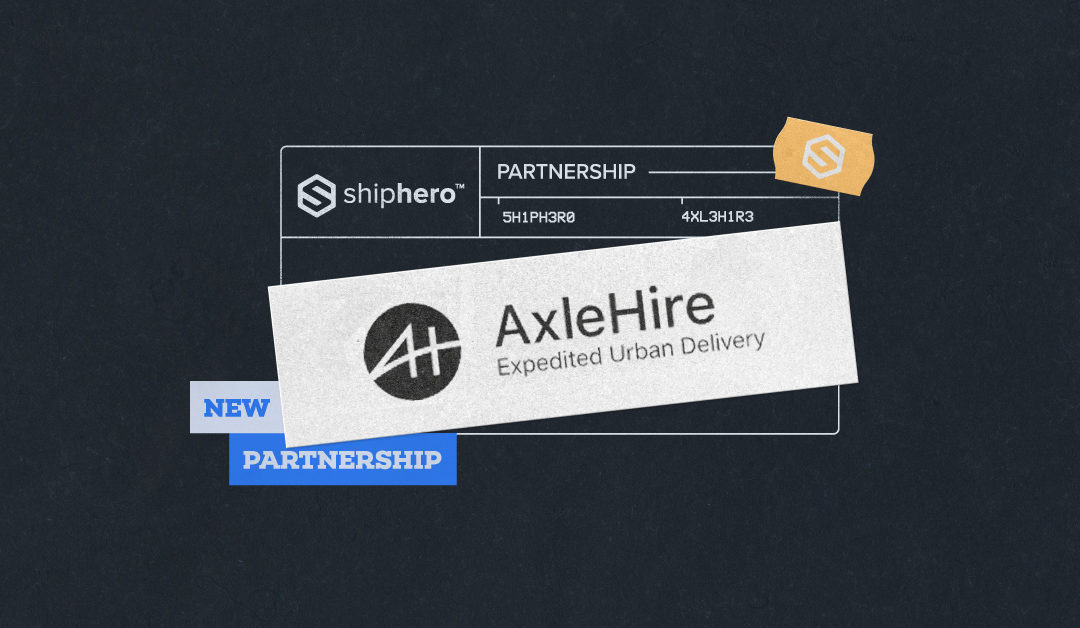
Jan 31, 2023 | newsroom
AxleHire Launches Last Mile Delivery for ShipHero In California and theTri-state Area with More to Come
EMERYVILLE, CA – AxleHire, an expedited urban last-mile delivery service, announced today that they are now providing a last-mile delivery service for ShipHero, the leading shipping and logistics platform for over 6,500 e-commerce brands and 3PLs. Currently active in multiple markets, including New York, New Jersey, Philadelphia and Southern California, AxleHire and ShipHero will bring tech-enabled, on-time delivery and a better overall delivery experience to ShipHero’s e-commerce clients and end customers across the tri-state and Southern California areas with plans to expand to additional markets.
AxleHire’s purpose-built technology and crowdsourced driver fleet can easily flex and scale to meet peak demand and support the rapid organic growth of ShipHero’s industry leading fulfillment solution. With AxleHire’s 99% on time delivery rate and real-time customer support, the partnership between ShipHero and AxleHire creates a simple, reliable, and seamless warehouse-to-doorstep solution for eCommerce sellers.
“AxleHire’s next-day and same-day delivery solutions allow us to stabilize costs for our customers, without concern for the expensive surcharges we’ve seen from major national carriers,” said Karen Schwartz, Head of Transportation at ShipHero. “AxleHire will enable us to reduce our dependence on the national carriers, while providing faster and more reliable deliveries. AxleHire’s reliability and commitment to support our vision of being the most trusted leader in the eCommerce fulfillment space.”
“ShipHero’s core value of always doing the right thing for their customers aligns well with AxleHire’s culture and values,” says AxleHire CEO Adam Bryant. “We look forward to partnering with ShipHero to achieve their mission of making it easy for brands and fulfillment providers to ship eCommerce and grow their businesses. It’s a partnership that will allow us to grow and expand together and we hope to be adding new markets in the near future.”
About AxleHire:
AxleHire is an expedited urban last-mile delivery service, providing customers with a superior same and next day delivery experience. AxleHire leverages purpose-built modern technology and a gig driver fleet to drive transformative outcomes that catalyze customers’ brand growth. Logistics teams can now provide a differentiated delivery experience at a competitive cost, overcoming the limitations of legacy delivery providers. AxleHire operates in urban areas across the U.S, enabling high-volume shippers to consistently cater to the rising needs and expectations of their customers.
For more information, please visit axlehire.com.
About ShipHero:
ShipHero is a US based, leading provider of cloud-based eCommerce fulfillment solutions that give online retailers and third-party logistics providers the tools to ship more efficiently anywhere in the world. With more than 6,500 customers located around the globe, ShipHero offers online retailers a suite of services ranging from warehouse management software to outsourced fulfillment as a service. Some notable customers include Momofuku, Depology and On a Mission Skin Care. Additionally, ShipHero is the official fulfillment network partner for Shopify, and is rapidly scaling a network of warehouses throughout the US to meet the growing demands of today’s online retailers.
Oct 19, 2020 | Blog, Fulfillment, News & Updates, Warehouse Management Software
Political Merchandise: A Logistical Triumph
Merchandise: the capitalistic solution for our innate human need to signal our fandom and find our tribe. Who doesn’t own a jersey from our coveted hometown or college sports team, or maybe you bought a t-shirt from your favorite performer? And now that presidential hopefuls act more like rockstars than politicians, political merchandise has infiltrated the United States’ presidential elections in a major way. From mugs to fly swatters to a bright red hat with the four-letter acronym that defined a presidential campaign, it seems that Merchandise Allows Giant Advantages; MAGA indeed.
So while the presidential candidates continue to duke it out through speeches, rallies, and debates, there is another constant underlying battle happening at the gift shops. Political merchandise has now become a crucial element in the United States’ presidential elections in terms of both fundraising revenue as well as brand awareness and reputation. In an election where everything rides on the candidate’s reputation, the logistics company outsourced by the campaign doesn’t just fulfill the orders, it also fulfills the promise of the candidate. Let’s dive into the role that merchandise plays in politics, and examine how nimble, outsourced logistics could be the defining competitive advantage in the upcoming election. So keep your eyes ON the merchandise!
The Booming Political Merchandise Industry
Throughout recent elections, political marketing has produced a booming multibillion-dollar industry, so campaign managers have closely collaborated with their merchandise team to develop and distribute trinkets, tokens, gag gifts, and apparel as an impactful way to effectively communicate the candidate’s campaign message and brand reputation. Political merchandising and promotional products have seen a giant spike in recent elections due in large part to the marketing minds behind the Donald J Trump presidential campaign, who was able to turn his patented “Make America Great Again” slogan into a $45 million market, reaping massive benefits for his campaign budget and influence.
During the 2020 election cycle, the Joe Biden Victory Fund and the Donald J Trump site each offer approved and sponsored political merchandise and promotional products, and all of the revenue from sales goes directly to fundraise for the political campaign. Conversely, websites like RedBubble and Etsy carry all types of items with the candidate’s name, likeness, and message; whether it is actually sponsored by the candidate remains unknown in many cases and the revenue from these products may or may not end up in the hands of the candidate. Such an example could be the Trump flag that boasts him with the muscular body of Rambo holding a massive rocket launcher.
Candidates have allowed these unauthorized third party sales to continue because it still propagates their message and grants them an extended reach, with the risk being that they could lose control of their message through decentralized distribution. However, in the 2016 election, Trump’s campaign began sending cease-and-desist letters to online retailers, providing a warning that the use of Trump’s name, likeness, and trademarked slogan is illegal infringements of a trademark. This year in 2020, that has not yet been the case.
One recent merchandise success story of the 2020 election stems from the famous fly that perched on Vice President Mike Pence’s silver spider web hair during the 2020 Vice Presidential debate. Before you could even utter “shoo fly” the Biden campaign was already selling “Truth Over Flies” fly swatters and the $10 knickknacks sold out by the next morning. A short three days later, bobbleheads of Pence with the fly sprung up as pre-orders by the National Bobblehead Hall of Fame.
The battle of merchandised political messages is all about reach, speed, and fulfillment: where can you deliver your message, how quickly can it be delivered, and how confident are you in fulfilling that message? With that in mind, how the respective campaigns plan to fulfill their merchandising promises requires further speculation.
Elect for the Right Logistics Company
“After the Democratic National Convention, it’s only a matter of months for a candidate to identify a brand, reinforce it, and promote it before the general election,” says Bruce Newman, a marketing professor at DePaul University and editor-in-chief of the Journal of Political Marketing. And in the instance of Mike Pence and the fly swatter, it could boil down to a matter of hours. So how do campaigns ensure that they can fulfill their merchandising promises and uphold their ever so important reputation?
Looking into the Joe Biden Victory Fund page, the site advertises that it is administered through bumperactive.com, which is a company that specializes in custom logos and decals on promotional products. The Biden campaign has wholly outsourced the manufacturing and logistics of their political merchandise for the sake of speed and expertise. They advertise on their site that delivery is in 7-10 days and any problems should be addressed through bumberactive.com.
Comparing this to the Donald J Trump shop page, the site does not indicate a third-party distributor. Instead, all inquiries should be routed directly through shop.donaldtrump.com. What is no doubt a strategic move by the Trump campaign to keep this information concealed to avoid meddling, the Trump campaign understands that any hiccup in fulfillment could cost them dollars, but more importantly, votes. The Donald J Trump shop website also advertises similar delivery times of 7-10 days.
Beyond just delivery, the ability to source, price, manufacture, and ship an item quickly is a huge competitive advantage, as seen with the Biden Fly Swatters example. In a statement to CBS News, the merchandise director for the Biden campaign was quoted as saying, “We saw the internet and our supporters sharing a viral moment online, so our digital team came together on the fly to show that Joe Biden and Kamala Harris will always choose truth over lies, science over fiction, and unity over division.”
With the goal of shipping quickly, the respective campaigns need to elect logistics companies that can be quick and nimble, and innovate on the fly (pun intended). Smart fulfillment companies like ShipHero allow e-commerce companies to source, pack, and ship quickly and to every corner of the United States. ShipHero boasts an average time to ship orders for new brands within as little as 3 days from signup. And through smart warehouses, state of the art technology, and innovations in transportation, ShipHero offers 2-day ground shipping reach for 98.4% of the contiguous US population. When deciding on a logistics solution, vote for speed, for reach, and for trustworthiness. Having a robust ecommerce order fulfillment solution is critical to the success of your business.
For the 2020 US elections, please do your part and vote! — https://www.headcount.org

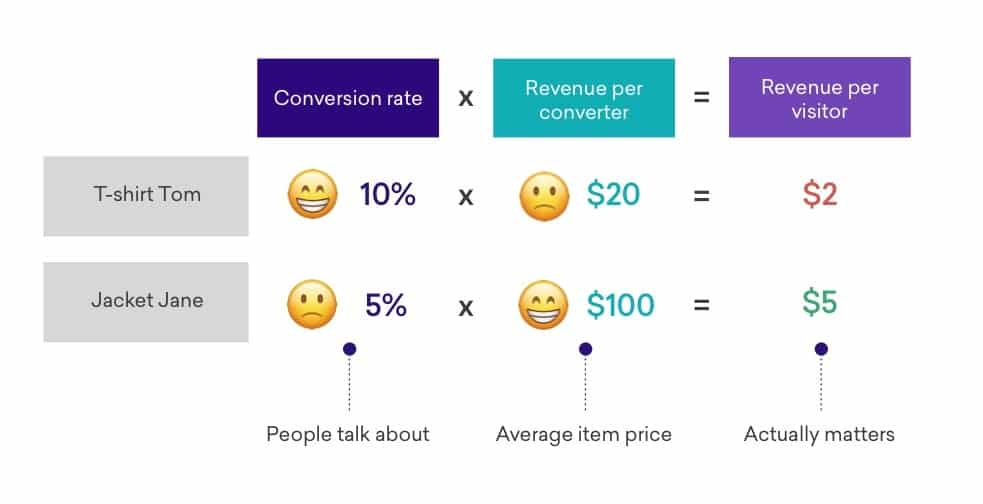
Oct 13, 2020 | Blog
What is Revenue per Visit?
And, how our best warehouse management software can help you fulfill all those new orders.
The trinity to e-commerce digital marketing excellence lies in three metrics: Average Order Value (AOV), Conversion Rate (CR), and Revenue per Visit (RPV). In this series, we will introduce how these metrics are gathered, how they impact your business, and how to improve each.
In this first part, we will discuss Revenue per Visit.
Revenue per Visit (RPV) is calculated as Total Revenue ($) divided by the Number of Visitors (#)
RPV is also calculated as Average Order Value ($) multiplied by Conversion Rate (%)

Revenue per Visitor and Your Business
Revenue per Visitor basically translates to: how much money does my business make for every person that visits my website.
RPV also allows you to gauge your new visitor acquisition efforts: are you attracting the right kind of visitor?
Notice it says visitor, not visit. The RPV metric does not use the total number of visits to your site in its calculations; rather, it counts only unique visitors, with each individual person counting as one visitor.
Revenue per Visitor (RPV) as a metric carries an important distinction from Average Order Value (AOV) and Conversion Rate (CR) — discussed in our AOV and CR blogs. WIth AOV and CR metrics, you are able to set targets, a desired number or percentage to achieve. For RPV, the importance lies in how the metric is trending, whether upwards or downwards.
- Positively-trending RPV — an upwards trend for RPV means that your website is attracting a larger amount of high-quality or qualified customers i.e., customers that are likely to convert upon visiting your site.
- Negatively-trending RPV — a downwards trend for RPV means that your website may be attracting more visitors, but these visitors are unqualified or less likely to convert.
RPV allows you to measure and determine your budget for spending on user acquisition, such as your advertising budget.
- Positively-trending RPV signals that your user acquisition strategy is working and the dollars you spend are paying off.
- Negatively-trending RPV signals a disproportionate growth of unqualified customers to your site, or possibly it can indicate a problem in your sales funnel, such as too many form-fields or possibly performance issues on your website landing page.
Calculating RPV
Let’s look at how to calculate RPV, and show the implications it can make for your business. Consider the following scenario:
Example 1
- Company A’s website has a total monthly revenue of $20,000 and 10,000 visitors; RPV = $2 per visitor
- Company B’s website has a total monthly revenue of $20,000 and 5,000 visitors; RPV = $4 per visitor
Example 2
- Company A’s website sells couches, so they have an AOV of $2,000 and a conversion rate of 1%; RPV = $2 per visitor
- Company B’s website sells clothing, so they have an AOV of $50 and a conversion rate of 8%; RPV = $4 per visitor
In both examples, it is apparent that Company B is attracting higher-quality and more qualified customers than Company A. Company B is also spending half of what Company A does in customer acquisition.
So, improving RPV could be the competitive advantage you need to succeed. Ready to start climbing?
Top 3 Proven Ways to Increase RPV
If you want to start on the path towards positively increasing your PRV, you need to start attracting the right customers to your site and providing them with the best experience. Here are the Top 3 Proven ways to do just that:
1. Attract the Right Customers
Attracting the right customer to your website is the best way to improve your RPV. Now, who are the right customers?
The right customers are those specific website visitors that are more likely to convert and hopefully contribute towards a higher Average Order Value (AOV). Oftentimes these are referred to as ‘qualified’ customers. These customers also have growth potential for their lifetime value — calculating Customer Lifetime Value is a great way to understand who the right customers are.
In analyzing your customer base of those that successfully converted, what common factors did they share if any? Any demographic or location similarities? Did they look at the same products? Did they check your ‘About Us’ page or Company Mission statement before converting?
Questions like these are what Data Analytics departments strive to answer, and it is the basis for your ecommerce business to take a data-driven and targeted approach towards marketing your business and finding the high-value customers or customers with a potentially large lifetime value. You should focus on retaining valuable customers, and getting rid of the rest.
After you identify and attract the right customers to your website, what’s next?
2. Sell, Sell, Sell
As discussed in our past blog about AOV, providing product recommendations, and upselling or cross-selling complementary products along the customer journey is an effective method to increase AOV.
To recap, the strategies to increase AOV are:
Product recommendations
Set order minimums
Increase prices
Upselling
Cross-selling
Urgency and Scarcity
Reward Programs
3. Offer the Best Experience
As discussed in our blog about Conversion Rates (CR), you must think about your customer journey from landing page to purchase confirmation. Each step in this process needs to be streamlined to reduce friction and increase your conversion rates.
To recap, the strategies to increase CR are:
Adding pop-ups
Simplify the first step
Chat boxes
Reduce form fields
Eliminate noise and distractions
Retargeting and remarketing
Conclusion
The above three methods are the top three proven ways to increase your company’s RPV.
Identify and market to your high-value customers
Sell more product per transaction and Improve the average order value (AOV)
Optimize the customer experience and improve conversion rate (CR)
This is the first part of our 3-part blog series covering essential e-commerce metrics: RPV, AOV, and CR. We hope you have a better grasp of how to measure the success of your e-commerce business. We’ll cover AOV and CR in future posts.
The beauty of your ecommerce company is that it can be easily measured and optimized; all you have to know is what to look for and how to turn the dials. Check back here to learn more about other metrics and tools of the trade.
And, if your warehouse is getting a surge of volume, we can help. We believe we have the best warehouse management software on the market. It will make your warehouse run like a finely-tuned Swiss watch, with great efficiency and minimal mistakes.

Jan 22, 2021 | Blog, The Packet
Front and Center
Walmartville, USA
Games like Tycoon City, MineCraft and SimCity just don’t cut it for this guy… Marc Lore, the head of Walmart eCommerce US, has announced that he is leaving Walmart at the end of January to start a “city of the future” built on a “reformed version of capitalism.”
The vision statement for the project reads: “Imagine a city with the vibrancy, diversity and culture of New York City combined with the efficiency, safety and innovation of Tokyo and the sustainability, governance, and social services of Sweden. This will be our New City.” Nobody tell this guy about Disney world…
So what will it look like?
For starters, each road leading into the city will be stationed with a senior citizen in a blue vest greeting you as you drive in… kidding. Details about the city have not yet been released, but Marc has promised that more information will be released over the coming months.
“This is going to be a lifelong project,” Marc says. “It’s the thing I’m most passionate about.” He plans to write a book and create a TV show to cover his city-building escapades. You can watch him describe his vision in the full interview here.
Who is future mayor Marc Lore?
Marc Lore is a serial entrepreneur that most famously founded Jet.com, a major competitor to Amazon, who then sold it to Walmart for $3 billion USD cash in 2016. He and his executive team arrived at Walmart with inside knowledge of Amazon, having previously sold his company Quidsi, a collection of online shopping sites best known for Diapers.com, to Amazon for around $550 million in 2011.
Since joining, Walmart eCommerce has seen tremendous growth, and Walmart.com became the second biggest ecomm site after Amazon in the US, quickly shedding its past reputation as an ancient relic in the new digital age of commerce.
Is this bad news for Walmart?
No. Walmart president and CEO Doug McMillon announced to the company that Marc will remain a partner and advisor for the company.
Back of the Packet
Inauguration
Aaaaaand they’re off! Our 46th President Joe Biden and our 49th VP Kamala Harris didn’t waste any time on their first day in office. President Biden signed at least 17 executive directives on things like COVID-19, the economy, climate change, and racial inequality.
Notably, Biden rejoined the Paris climate deal, while disallowing the permit for the Keystone XL pipeline. He also placed a mask mandate on all federal property, and issued to Americans a challenge… not to dump ice water on your heads or inhale a spoonful of cinnamon, but instead to mask up for 100 days. Sounds do-able.
As for the inauguration ceremony, Lada Gaga with such beauty and grace kicked off the 2021 Hunger Games.

At the same time, Bernie kicked off a global fashion craze. Our professional advice for the fashion and accessory industry is that people will be going gaga over giant brooches and earth-tone plaid print gloves.

Vaccine Stipend
A growing number of grocers are offering their employees paid incentives to get vaccinated against COVID-19.
This week, Aldi announced to employees that they would receive compensation for getting vaccinated, two hours of pay for each of the two vaccine doses and that they would be paid their hourly wage on top of that. Not a bad deal.
Aldi joins the ranks of Trader Joe’s, Dollar General, Instacart, and others that are incentivizing their employees to get the vaccine.
“Providing accommodations so employees can receive this critical vaccine is one more way we can support them and eliminate the need to choose between earning their wages and protecting their well-being,” said Jason Hart, CEO of Aldi U.S.
ShipHero News
We’ve Invented the Wheel
It’s no secret that today’s world of ecommerce is changing rapidly. Third party logistics (3PL) and fulfillment providers that don’t find a way to keep up with, if not surpass, the pace of growth during this ecommerce boom is at serious risk of getting left behind.
That’s why we invented The Fulfillment Innovation Wheel: a list of twelve capabilities and service offerings that 3PLs need to implement in order to be successful, as well as the capabilities and service offerings that retailers and brands should look for when partnering with a 3PL.
Stay tuned as we break down each of the twelve capabilities, starting with Designed for Returns.
Get Featured
We are reaching out to our Packet community. Would you like to share with us stories about your ecommerce experiences, whether it’s how you started your business, what opinions you have on the stories we share, or if you just feel like venting… we’re here for you.
Email us at thepacket@shiphero.com and you could be featured on an upcoming edition of The Packet, or if you’re lucky, you could be invited to join one of our many Podcast episodes or featured on our Blog!
Check out the packets you missed here and Subscribe below so you don’t miss the next one!
Oct 23, 2019 | Blog, Case Study
We realized there was no way we’d be able to continue filling orders one year down the road at the rate we were growing. We were excited by the growth, but we needed a software solution like ShipHero.
— Jake Rajsky, Vice President, American Tall
Challenges
Scaling fulfillment with rapid business growth
Finding high-quality, well-tailored men’s clothing online can be a tall order—especially for men who are 6’3” or taller. So there was high demand when American Tall, a men’s apparel brand, launched their direct-to-consumer ecommerce site.
At first, the small family business relished picking and packing each order by hand. They even enclosed personalized thank- you cards with each order. But as their business grew, keeping up with order fulfillment became a challenge.
Download Case Study
Oct 8, 2020 | Blog
You are an eco-conscious consumer. Maybe you turn off and unplug your lights, or you try to reduce water consumption. You may buy second-hand products, or perhaps you are well-studied on the long, long list of rules for recycling.
Maybe you carpool or ride a bike, or you have a garden and shop for organic produce. You do all the eco-friendly things that would make Al Gore blush; but now consider this inconvenient truth: each and every time a package arrives on your doorstep within 48 hours of ordering, also known as same-day delivery or two-day delivery, the environmental costs of such an expedient service are wasting all of your carbon-diminishing habits.
“The time in transit has a direct relationship to the environmental impact. I don’t think the average consumer understands the environmental impact of having something tomorrow vs. two days from now. The more time you give me, the more efficient I can be.” That is a quote from Patrick Browne, director of global sustainability at UPS.
The advent and booming popularity of same-day and two-day delivery have forced delivery and fulfillment companies to take more inefficient and carbon-intensive routes, passing both the financial and environmental costs on to the consumers. Yes, the shipping may appear to be ‘free’, but that is because notable e-commerce giants are fronting the logistics costs for competitive reasons while doing all they can to disguise the true costs, the harm to our environment. Cue Captain Planet.
Let’s delve into the environmental impacts of the services provided by these e-commerce giants, and then examine carbon-friendly solutions with promises of the exact same delivery times.
The Cost of Consumer Expectations
You wake up in a cold sweat. It is your dear mother’s birthday tomorrow, and you have nothing, nada, zip, zilch, diddly-squat… just like last year. You’re out of excuses, and more importantly, out of time. What is a desperate son or daughter to do? Well have no fear; up in the sky, look! It’s a bird, it’s a plane, no! It’s a delivery drone coming to your rescue. Ah, the future.
The trend of faster delivery times, from click to door, has always been a point of competition amongst e-commerce companies, with a 2019 study conducted by Rakuten Intelligence showing that delivery times have been steadily decreasing the previous two years from 5.2 days to 4.3 days. And today, over 50% of shoppers between 18-35 years old have reported that they expect same-day shipping and will opt for speed of delivery; however, 90% of consumers reported that they would opt for free delivery over speedy delivery.
So, are you willing to trade speed for the eco-friendly, green alternative? If so, you are in the vast minority. A study by Forbes in 2019 showed that 95.6% of consumers were not willing to make the trade-off of speed for package consolidation, and 54% of consumers mention ‘speed of delivery’ as their top delivery consideration when shopping.
Our expectations as consumers are trending towards not only the same day but within 1-3 hours for some products. The promise of e-commerce was economies of scale, allowing companies to synergistically ship orders to your door in a more environmentally-friendly way when compared to each consumer driving to the store in their own cars. These initial environmental benefits are now at risk as shipping gets artificially pushed to be faster and faster.
Environmental Costs of Shipping
You may be thinking, how bad is bad? Well, in the worst-case scenario, a package delivered the same-day could result in carbon emissions up to 35 times more than if the delivery had been done efficiently. These abhorrent emission numbers can stem from carriers relying heavily on air freight, which values speed, instead of the lower carbon option of ground freight.
Transporting 2 tons of freight over 500 miles with a truck creates just 12% of the carbon emissions used to do the same with a plane. That’s right, give a trucker a hug. The air freight option is much more expensive and carbon-intensive than ground freight and is used solely in the case where goods need to be shipped long distances, quickly. This, of course, requires a lot of energy and fossil fuel.
Not only does air freight emit over 8 times the carbon, but the effects of these emissions are also 2 to 3 times more harmful compared to carbon emissions from ground transportation because airplanes release the carbon at high altitudes into the atmosphere, where they contribute much more to the greenhouse effect.
While larger delivery companies are able to combat a portion of these added carbon emissions by purchasing more carbon-neutral vehicles or packaging, the large majority of companies that are struggling to compete, such as meal kit delivery or razor subscription box companies, just cannot afford to be environmentally-friendly, and unfortunately, it will be all of us that will pay the price.
Solutions for Low Carbon Delivery
“But it’s my mom’s birthday tomorrow and I need to get something, like, today!”, you may be saying to yourself. Or, “Shouldn’t that be the company’s job to be environmentally friendly?” Well, absolutely. Here are some ways that companies are meeting consumer expectations for quick service, all while reducing the added carbon footprint.
Implementing Machine Learning
One of the major trends in 2020 for delivery and fulfillment will certainly be the injection of Artificial Intelligence (AI) and Machine Learning into the supply chain. According to McKinsey & Company, businesses can expect to gain between $1.3 trillion to $2 trillion a year in economic value by using AI in their supply chains.
These computing solutions have limitless potential to transform the supply chain and logistics network. The main impact of these solutions can be found in the following areas:
- Predictive demand: tuning Machine Learning models to predict and forecast demand, using order metrics, product data, and real-time KPIs, will allow companies to shorten shipping distances, lower delivery time, and eliminate the need for carbon-intensive air freight in some circumstances.
- Smart Warehouses: Smart warehouses are able to simplify and automate the tedious tasks of picking, packing, and shipping, thereby creating a greener and more cost-efficient system.
- Route Optimization: Route planning using real-time location data allows companies to optimize ground routes with various stops, allowing them to fill ground vehicles more efficiently and aim to reduce fuel consumption.
Delivery and smart fulfillment companies like ShipHero are realizing the potential of Artificial Intelligence and Machine Learning to solve the complex problems presented by logistics and supply chain operations; and when configured correctly, Machine Learning has the ability to help key business leaders get the real-time information they need to make smart decisions.
Considering the present-day state of shipping and delivery during the COVID -19 pandemic, with shipping carriers at capacity and consumer demands at all times high, companies must rise to meet this watershed moment where e-commerce has seen 5 years of growth… in just four months. So being able to combine these new technologies, a wide fulfillment network, and transportation optimization will present a radical new shift for e-commerce logistics.
Reducing Waste
Single-use and disposable materials are terrible for our environment, filling up landfills, waterways, and the bellies of poor turtles. Fulfillment companies like ShipHero are switching to recyclable packaging, thereby eliminating single-use materials, and using sustainably sourced paper and recyclable packaging.
Waste can also be created by overproduction, unnecessary inventory, and unnecessary transportation, all of which can be addressed and reduced through a smart fulfillment platform set with a goal to lower and optimize carbon emissions. So how can companies measure their carbon emissions?
Transparent Reporting and KPIs: A Competitive Advantage
Almost half (46%) of surveyed global consumers said they would be willing to forgo a brand name in order to buy environmentally friendly products. In this information era ripe with cancel culture, brands should be sure to show-not-tell their customers how they are being eco-conscious, lest join the expanding list of canceled brands.
Over 73% of global consumers say they would definitely change habits to reduce environmental impact and over half of shoppers choose brands based on sustainability; so, brands that are notably eco-friendly like Lush Cosmetics, Patagonia, and TOMS make sure to advertise just how eco-friendly they are. In order to meet the expectations for this majority of consumers, companies must be able to demonstrate this competitive advantage through transparent reporting and Key Performance Indicators (KPIs).
When warehousing, distribution, and fulfillment activities are all performed by a singular entity, carbon emissions and footprint are much easier to monitor, optimize, and report. These are brand new reporting capabilities that could not have been made under standard fulfillment methodologies, and now these capabilities can be developed even further. Taking the approach to continually build out more eco-friendly reporting services at a steady pace, ShipHero can make a difference now, all while continuing to evolve them over time; and they even envision a future service where carbon savings are published and available for every shipment with a simple scan of a QR code included on the shipping label. What’s important to note is that ShipHero does all of this while maintaining the exact same delivery times (between 3-5 days) that you and your consumers have come to expect.
Then, these carbon emission optimization metrics are passed onto you, so that you can communicate them to your loyal, eco-aware customer base.










